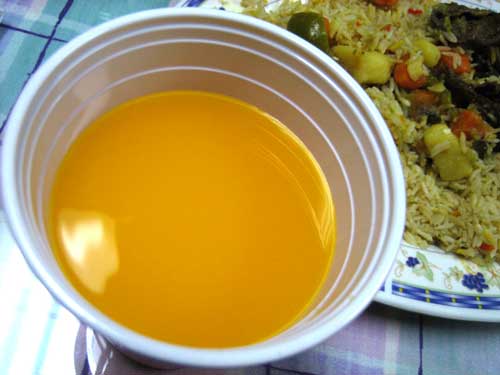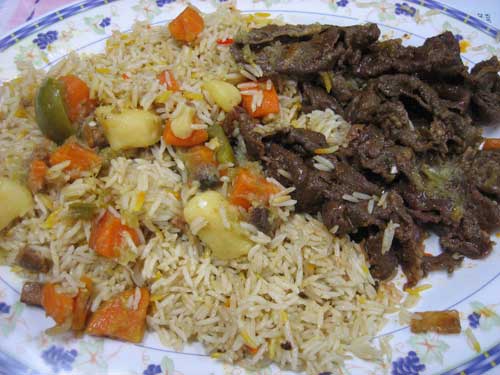From the Bollard
July 1, 2007
Off the Eaten Path
By Zachary Barowitz
 |
(photos/Zachary Barowitz) |
 |
 |
 |
Al-Amin Halaal Market
269 St. John St., Portland
774-3220
Partitioned off by a wall of peg-board, the back room at Al-Amin Halaal Market is not so much a restaurant as it's a place for Somali guys to eat stew and hang out between prayers. The dining room has no sign to advertise it. It's accessed either through the grocery store or via a separate entrance on the corner of St. John and A streets, about a block from the Greyhound station.
If you've never been to Al-Amin, I suggest entering through the front room to peruse their stock of "native" goods and take solace in the fact that Somalia's trade imbalance makes ours seem insignificant: you'll find sandals from China, bags of instant basmati rice from Pakistan, nestle formula from Wal-Mart, tins of dates from Saudi Arabia, and a man cutting frozen blocks of goat meat on a band saw.
Until recently, Al-Amin sold camel meat (called Hilib geyl in Somalia) imported from Australia. Whole, stuffed camel is the largest single-course dish in the world (it has a whole lamb stuffed into its carcass, and the lamb, in turn, is stuffed with dozens of chickens, like a giant desert turducken). Unfortunately, there are no camel carcasses hanging in the store, just boxes of frozen meat labeled "Product of Australia." The Aussies imported several varieties of camels to uses as pack animals, the progeny of which now run feral in the great outback; the exported meat apparently comes from hunting these wild beasts.
With her very limited English, a woman at the store gave me muddled but extensive cooking instructions for chunks of stew meat, and trumpeted the health benefits of camel. Per her instructions, I simmered small chunks of meat for a long time in a deep skillet, replenishing the water frequently. To replicate the dish, try chewing on a belt.
Anyway, once in the back room, you'll see an ornate portal that leads to an even further-back room. This chamber looks like it might be a prayer room, but is usually occupied by card players. You order at the counter – if no one is available right away, pour yourself a Styrofoam cup of sweet chai from the urns and top it off with some evaporated milk from the cans nearby. The tea is a highlight: not overly spiced, but almost syrupy on account of its sweetness and the concentrated milk.
Somali food is not unlike Ethiopian food, in that it involves various types of stew served on a flat bread, injera, which is like a soft, stretchy, somewhat rubbery and slightly sour pancake. Unlike Ethiopian or Eritrean food, Somali cuisine has a Pakistani influence; samosas are popular, as is seasoned basmati rice. Al-Amin's regular menu items are roasted chicken and goat, beef stew, strips of braised beef "steak," broiled tilapia, and vegetables. The availability of these items, however, is inconsistent, so I usually order by saying, "Whatever you have," accompanied by a throw-stuff-on-gesture. In a few minutes, a large plate will be presented to you, and if you are lucky, a glass of orange Tang.
The place is friendly. The TV is usually turned to CNN. Generally, the only women you see are those cooking or taking orders. As in much of the world, utensils are not used. If you want to go native, pull off a small piece of bread, drop it over a bite of stew, fold it and quickly pop it in your mouth. If you are eating rice, form it into a small ball on your plate and flick it into your mouth using the back of your thumb as a shovel (you may want to practice this at home first).
The best dishes are the steak, fish, and mixed vegetables served on the soft, chewy, slightly sour bread. The par-boiled basmati rice tends to be a bit dry. The steak is braised or sautéed in a thick, slightly sweet gravy, though on recent visits it was in a less interesting, vinegary sauce. The beef stew is served in a light curry, but is not terribly interesting. Likewise, the roasted chicken is not exotically prepared. The big, meaty chunks of goat have a good, gamey flavor and a rich, reddish-purple color, but would be better served falling-apart tender rather than gnaw-the-bone tough. The fish, tilapia, is well cooked, with a savory crust, and the mixed vegetables are nicely spiced. Usually, you'll also get a salad (iceberg lettuce, some onion, and maybe a slice of tomato), a spicy green sauce and a small dish of yogurt. A plate costs between $8 or $10.
If you catch them at the right time, when the injera is fresh and the kitchen is stocked, the food can be excellent. At other times, it's unremarkable. I have not been able to figure out their schedule.
I first started going there around Ramadan with a friend from Maine College of Art who is fond of talking shop and wont to use the school's acronym when doing so – "I just got back from MECA… I'm getting fed up with MECA… Everywhere I go, I see people from MECA" – oblivious that the good Muslims in our midst might get a very different impression of our conversation (we dropped a dollar into the support-a-mosque box just for good measure). Those meals – preceded by a peppery bowl of post-fast, stomach-coating oatmeal – were taken in the evening, but at the end of the holy month, I was told that service is mostly provided during lunch. This turned out to be a more ambiguous instruction than it might seem. For example, one day when I came in before noon, I was told to come later; when I came in a couple days later after three, I was told the food was no more, but that I should try them for breakfast.
The food is worth the effort.